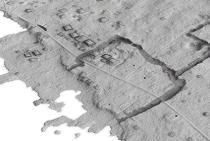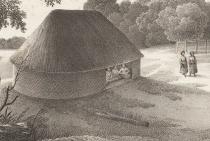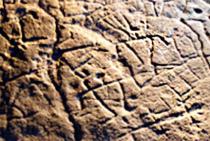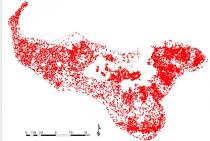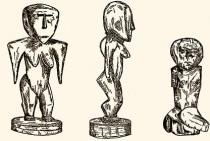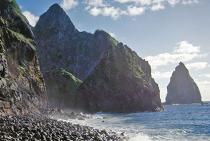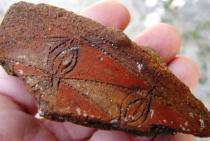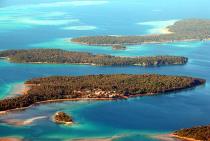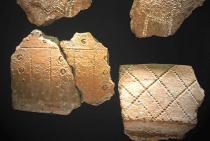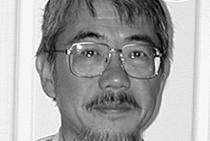New evidence of one of the first cities in the Pacific shows they were established much earlier than previously thought, according to research from The Australian National University (ANU). The study used aerial laser scanning to map archaeological sites on the island of Tongatapu in Tonga. “Earth structures were being constructed in Tongatapu around AD 300 -- 700 years earlier than previously thought,” said the Lead author, PhD scholar Phillip Parton.
You are here
Results for archaeology
Thursday 11 April 2024
Canberra, Australia
Tuesday 18 July 2023
Nuku'alofa, Tonga
Seventeen hundred years before the dawn of the Viking Age in Europe, the first Polynesians crossed the western flank of the Polynesian triangle to settle in Tonga. Thus began the final chapter in the human settlement of the globe. A newly released book, ‘The Birth of Polynesia: An Archaeological Journey Through the Kingdom of Tonga’, documents this story. The author David V. Burley, is currently visiting Tonga.
Monday 21 November 2022
Nuku'alofa, Tonga
Pacific island nations suffered severe depopulation from introduced diseases as a consequence of contact with European vessels, a new study from The Australian National University (ANU) shows. Researchers Phillip Parton and Prof. Geoffrey Clark found that Tongatapu had a population decline of between 70 and 86 per cent once Europeans made contact and introduced new pathogens.
Saturday 15 August 2020
Nuku'alofa, Tonga
The beach and lagoon at Houmale‘eia on the north end of Foa Island in Ha‘apai is a spectacular place. Now home to Matafonua Lodge, its ancient history came vividly to life in 2008 when Australian visitors inadvertently discovered a kaleidoscope of images carved into a beach rock surface. Human feet, triangular bodied people, lizards, dogs, turtles and other representations hinted astoundingly at a Hawaiian connection. By Shane Egan and David Burley.
Saturday 27 June 2020
Nuku'alofa, Tonga
Burial mounds are widely scattered across the Tongatapu landscape. When you land at Fua’amotu airport, they line the runway. When you drive into Nuku’alofa, they can be seen to either side of the road. All but a few are without name, and the individuals buried within are long lost to history. Yet these mounds represent a story that literally is inscribed on the landscape. Using airborne LiDAR data, a computer application was developed to count the mounds. The total was astounding, including upwards of 10,000 of these sites on Tongatapu - about 40 mounds for every square kilometre. By Travis Freeland and David V. Burley.
Saturday 16 May 2020
Nuku'alofa, Tonga
On November 2, 1866, the Reverend Shirley Waldemar Baker, missionary and eventual Prime Minister of Tonga, gave a lecture in which he describes the last traditional God House in Ha'apai....“I have stood in the old Fale Mee at Haano, which is the last fale otua (temple of their god) still standing in Haapai. At the foot of the principal post there is buried a man, who was said to be the best singer in all Tonga. He was offered a living sacrifice to the god at the building of the temple, as an act of dedication.” By David V. Burley.
Thursday 16 April 2020
2 comments
Nuku'alofa, Tonga
‘Ata, Tonga’s southernmost island, is a long way away, separated from Tongatapu by 160 km of open ocean. ‘Ata’s place in the history books is well established. It was here, in June 1863, that the whaling ship Grecian under Captain Thomas McGrath anchored off the northeastern shore and only village, Kolomaile. The details of the events that followed are sketchily recorded, but the consequence is notorious. A large number of ‘Ata’s residents were lured on to the ship, captured, and then sold to a Peruvian slaver for transport to Lima. None were to return. In the aftermath of the raid, and under the orders of Tupou I, the remaining ‘Atans were resettled on ‘Eua, in a village they again named Kolomaile. By David V. Burley.
Thursday 19 March 2020
Nuku'alofa, Tonga
Tonga's stunning ngatu provide testimony to the considerable antiquity of Tongan artistic designs. Variation of the ngatu patterns, and the way these are organized, had been inscribed on the surfaces of Lapita pottery in Tonga almost 3,000 years ago. By David V. Burley.
Friday 7 February 2020
Nuku'alofa, Tonga
People first arrived in Vava‘u between 850 and 810 BC, establishing themselves on the south central islands offshore of ‘Uta Vava’u. The earliest sites at Ofu, Pangaimotu and Otea are all but identical in their age, and they are coincidental with the oldest sites in Ha’apai. Bird remains aside, excavations of other types of food remains at these sites have an unexpected story to tell: one of scarcity. Fish remains were shockingly limited! Shellfish counts and species diversity are similarly impoverished, illustrating limited productivity, or at least limited sustainability, for reef foraging efforts. By David V. Burley.
Monday 16 December 2019
Nuku'alofa, Tonga
Tongatapu was a far different place 3000 years ago, one few of us can imagine today. The sea was higher, almost 1.4 m higher. Much of the land on which the city of Nuku‘alofa now sits was not land at all. It was about 900 BC when voyaging canoes first arrived from a homeland to the west. These kalia carried a small group of people and all of the necessities they would need to settle new found islands. They were the first Tongans. By David Burley
Monday 7 January 2008
 Premium content
Premium content
Nuku'alofa, Tonga
Nukuleka, a small fishing village on the northern shores of eastern Tongatapu, at the entrance to the Fanga'uta Lagoon, has been identified by a Canadian archaeologist, Professor David V. Burley, as the cradle of Polynesia.
Tuesday 1 June 2004
 Premium content
Premium content
Nuku'alofa, Tonga
Prof. David V. Burley, with 17 students and an assistant from the Simon Fraser University, British Columbia, Canada, visiting Tonga in June destined for Vava'u to carry out some excavation work to ascertain the first settlement of Vava'u by ancient Tongans.
Saturday 30 September 2000
 Premium content
Premium content
Nuku‘alofa, Tonga
The mystery of where the Tongan people came from 3000 years ago, continues to intrigue scholars from around the world. Helping to trace the origin of our ancestors, their way of life, and their migration from Tonga to the rest of Polynesia, a group of Japanese scholars visited Tonga in mid-August in preparation for a two-year research program, which they hoped to start in August 2001. From Matangi Tonga Magazine Vol. 15, no. 3, September 2000.


